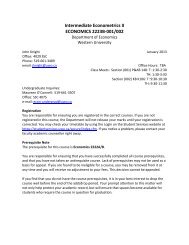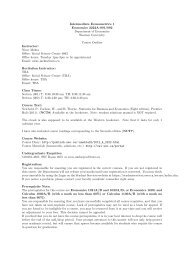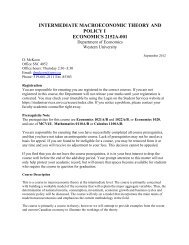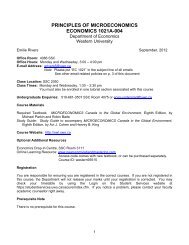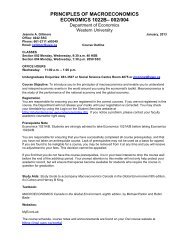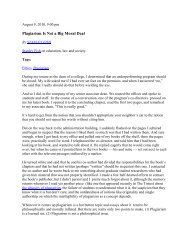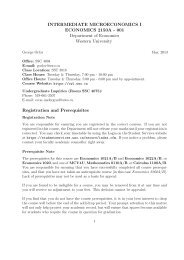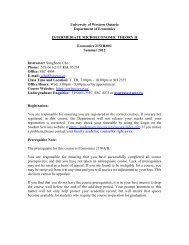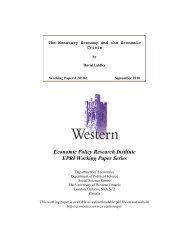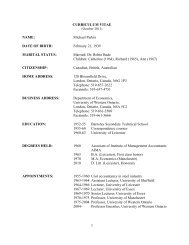The Transferability of Skills - Economics - University of Western ...
The Transferability of Skills - Economics - University of Western ...
The Transferability of Skills - Economics - University of Western ...
You also want an ePaper? Increase the reach of your titles
YUMPU automatically turns print PDFs into web optimized ePapers that Google loves.
CIBC Centre for Human Capital & ProductivityIn two recent CIBC Centre WorkingPapers (2008-3 and 2011-5), ChrisRobinson empirically examines thetransferability <strong>of</strong> skills by measuringhow job skill requirements change forworkers when they switch employers,voluntarily or involuntarily. He furtherexamines the extent to which changesin skill utilization across occupationsimpacts the wages <strong>of</strong> workers thatswitch jobs.Workers may change jobs voluntarilyfor personal reasons or to move aheadpr<strong>of</strong>essionally. Following a move up acareer ladder, the new job may be quitedifferent from the old one, involving apromotion to a different occupationin which all skills are used at a higherlevel. Not surprisingly, these moves aretypically accompanied by wage gains.By contrast, involuntary moves tend toresult in skill utilization downgrades andwage declines. Interestingly, voluntaryand involuntary moves tend to result inchanges in skill utilization <strong>of</strong> a similardegree — only the direction <strong>of</strong> thechange differs.JobDisplacementand Skill<strong>Transferability</strong>In “Human Capital Specificity:Evidence from the Dictionary <strong>of</strong>Occupational Titles and DisplacedWorker Surveys 1984 2000”, Robinson(with Maxim Poletaev) explores theskill and wage losses associated withinvoluntary worker displacementfrom plant closures. Some workersexperience sizeable wages losses, whileothers see little or no decline in theirwages. As one might expect, the extent<strong>of</strong> wage loss depends on how closelyrelated the skill requirements for thepost-displacement job are to thoseused in the pre-displacement job(i.e. the transferability <strong>of</strong> skills).Based on data from the 1984-2010United States Displaced WorkerSurveys, roughly one-third <strong>of</strong> displacedworkers find new employment inthe same occupation class. <strong>The</strong>seworkers experience relativelysmall wage losses averaging 5%.Other workers switch occupationsaltogether. Roughly one-in-fourdisplaced workers make a significantswitch in the type and amount <strong>of</strong>skills used in their occupation.<strong>The</strong>se workers experience sizeablewage losses averaging 17%. Finally,among displaced workers who switchoccupation but manage to avoid asignificant change in the type andamount <strong>of</strong> skills utilized, wage lossesaverage a more modest 9%. See Box1 for a detailed description <strong>of</strong> how theskills used in different occupations aremeasured, along with correspondingmeasures <strong>of</strong> ‘occupational distance’.Box 1 - Measuring ‘Occupational Distance’Measures <strong>of</strong> how close any two occupations are in terms <strong>of</strong> the skills theyuse – referred to as ‘occupational distance’ – are calculated using datafrom a detailed examination <strong>of</strong> over 12,000 jobs in the U.S., known as theDictionary <strong>of</strong> Occupational Titles (DOT). Job analysts scored each job interms <strong>of</strong> a large number <strong>of</strong> characteristics, such as the required level <strong>of</strong>finger dexterity, the level <strong>of</strong> mathematical or writing ability, the requiredamount <strong>of</strong> strength, etc. Using a technique known as factor analysis,Robinson and Poletaev condense this information to associate with eachoccupation a level <strong>of</strong> four basic skills, called a skill portfolio, each derivedfrom the analysts’ measures <strong>of</strong> all job characteristics. <strong>The</strong>se four basicskills roughly correspond to ‘general intelligence related’, ‘fine motorskills related’, ‘strength and gross motor skills related’, and ‘visual skillsrelated’. Any two occupations are considered similar if they have similarskill portfolios. Occupations may differ for two reasons. First, they mayuse a different mix <strong>of</strong> skills. For example an accountant uses a high level<strong>of</strong> mathematics but a low level <strong>of</strong> strength compared with a constructionworker. Second, occupations may use similar types <strong>of</strong> skills, but they mayuse them at very different levels.Most <strong>of</strong> the analysis discussed in this brief focuses on changes in skills andwages associated with movements across the nearly 500 occupationsdistinguished in the U.S. three digit occupation coding system. However,not all jobs within an occupation code have the same skill portfolio. Basedon data from the DOT, the average distance <strong>of</strong> random within-occupationmoves is about half the average for random moves across occupations.Thus, skills are not fully transferable across jobs even for displacedworkers who remain in the same occupation class. Unfortunately, it is notpossible to link changes in skill requirements across jobs within the sameoccupation to associated changes in wages, since standard data sets thatcontain wage measures, such as the March Current Population Surveysand Displaced Worker Surveys, do not measure jobs at a finer level thanthe three digit occupational classification.



